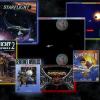Some techniques for creating aliens?
Hey folks. I have a couple of odd ideas for creating low-poly alien creatures for use in a 3rd person game, but I'm not versed enough in art to know how difficult this would be from a content creation point of view. I'd appreciate any thoughts you might have.
The scheme is to model a bunch of body parts like stabbing tentacles, multiply jointed limbs and whatnot, then animate them using a partial skeleton. The main torso of the creature would be modeled seperately and a tool used to indicate attachment points, orientation, movement clearance info and acceptable body part types.
Texturing would be handled with procedural textures if possible, or a stock set if that ends up looking crappy. (They don't have to look beautiful, but they shouldn't look amateurish).
If I understand skeletal animation correctly, you could then swap in similar meshes. What I don't know is whether or not it would be possible to scale or distort the resulting skeleton in real time so that you could do things like create a greater gap between a creature's legs, extend its arms away from its body or even have a mutated creature with one arm higher than another.
An example of this might be: You model two limbs and give them a vertical raking / scratching animation with an independent partial skeleton. Then you model two legs and create a walking animation, with an independent partial skeleton. These all get attached to hardpoints on an upright torso with its own skeleton. I don't know about dynamic IK, but there would have to be some mediation by the software to keep the body parts oriented and connected properly as the creature moved.
Aside from specifying hard points, the art tool would also allow the artist to specify morph normals or faces. This way, the same mesh could hold the parameters for more or less muscular looking beasts, randomly varied in real time. I know this will distort textures, but I don't see a way around that other than to discourage the creation of textures which will obviously appear mangled (so spots and patterns are better).
One HUGE problem I see is that creatures will likely be limited to simple animations because of the possibility of geometry colliding with itself. But simple anims would be just fine because the whole goal is to fill out biospheres which will otherwise be VERY empty.
Can this concept work at all? I've heard of a zombie game that might be doing this.
What issues am I missing, or should be much better informed on?
Can you point me to any useful research or links, or any other folks trying to do this?
Thanks for any help you can give!
--------------------Just waiting for the mothership...
I think a lot of what you want to do will be limited by the 3D app you use. You can usually save animated skeletons separate from a model, for use on other meshes. And, many programs support merging an animated portion of a skeleton to another animated mesh. There are also scripting tools such as Python and others that will allow interesting combinations. But are you thinking this as a time saving technique when you go to animate your aliens? Or as a means to have aliens with interchangable limbs/parts? Or do you just want to be able to create a large variation of similar aliens without having to re-do the animations? I ask, because what you described can be a pretty good way of modelling (creating separate pieces that are merged to a torso) but usually the animating comes after a nice merged mesh has been created. I guess it depends on how specific you want to get, and what modelling/animation package you use.
Quote: Original post by Wavinator
The scheme is to model a bunch of body parts like stabbing tentacles, multiply jointed limbs and whatnot, then animate them using a partial skeleton. The main torso of the creature would be modeled seperately and a tool used to indicate attachment points, orientation, movement clearance info and acceptable body part types.
Unless your models are very robotic and not organic, mixing and matching will cause skinning to be very screwed up. It's practically impossible to get the soft skin weights to be correct automatically, the artist absolutely needs to modify them for each particular joint. You can certainly use different models with your skeletons and you can scale the skeletons as necessary but you'll inevitably going to run into skinning issues. Unless the artist binds the skin to the skeleton for each particular combination manually, you'll run into visual artifacts.
Quote: Original post by DrewCaliburClark
But are you thinking this as a time saving technique when you go to animate your aliens? Or as a means to have aliens with interchangable limbs/parts? Or do you just want to be able to create a large variation of similar aliens without having to re-do the animations? I ask, because what you described can be a pretty good way of modelling (creating separate pieces that are merged to a torso) but usually the animating comes after a nice merged mesh has been created. I guess it depends on how specific you want to get, and what modelling/animation package you use.
Thanks for the great info. I was hoping that this scheme could be used to create a wide variety of aliens. Having interchangable parts should help a little with the eye fatigue that would otherwise be inevitable as you encounter the same pool of creatures across various worlds.
I had thought that gMax, Unwrap3D, Wings3D and Milkshape might be the tools of choice. I know the later 3, and since so many artists have experience with max I might legitimately be able to get work done in gMax.
--------------------Just waiting for the mothership...
Quote: Original post by CoffeeMug
Unless your models are very robotic and not organic, mixing and matching will cause skinning to be very screwed up. It's practically impossible to get the soft skin weights to be correct automatically, the artist absolutely needs to modify them for each particular joint. You can certainly use different models with your skeletons and you can scale the skeletons as necessary but you'll inevitably going to run into skinning issues. Unless the artist binds the skin to the skeleton for each particular combination manually, you'll run into visual artifacts.
Hmmm... does this apply if the limbs themselves are seperately skinned from the body? I have heard of techniques, I think with some Half-Life models, where the legs are actually seperate from the body (?) and you only notice this in certain kneeling anims.
What I am hoping to be able to do is to get my engine to merge meshes without artifacts. Phantasy Star Online does this and what you get are certain biological entities like breathing lungs and moving vicera (in this biomechanical level) that move in and out of other polys without graphical effects.
I have a perspective constraint that may help this, as well: The game is 3rd person and somewhat removed from your character (think size of characters in an isometric game). So you don't have to see detailed connection of joints with the main body's mesh.
--------------------Just waiting for the mothership...
To solve the skinning issue, you might simply want to close the limbs. i.e. only use closed meshes, and dont "fuse" them.
This would make you use extra polygons, but this would have the advantage of allowing you to have correctly skinned limbs, and less headaches with joints.
I was thinking you might wanna check out Incredible Creatures (IIRC). You know, that game Relic did where you can create new creatures by mixing them. I am sure this would be interesting to you especially since they had quite a good mix of creatures (not just mammals, for a start).
This would make you use extra polygons, but this would have the advantage of allowing you to have correctly skinned limbs, and less headaches with joints.
I was thinking you might wanna check out Incredible Creatures (IIRC). You know, that game Relic did where you can create new creatures by mixing them. I am sure this would be interesting to you especially since they had quite a good mix of creatures (not just mammals, for a start).
-----------------------------Sancte Isidore ora pro nobis !
Quote: Original post by Wavinator
Hmmm... does this apply if the limbs themselves are seperately skinned from the body?
But what are you planning to do at the points where the limbs are supposed to join the body? If you simply put them close enough (perhaps sink them into the body a little) you shouldn't encounter any artifacts but your atists will be severely limited by this technique. You should really talk to the people that are doing the skinning how much of a problem this would be. Considering that you have perspective constraints that might actually help you, this may very well be a viable solution.
This topic is closed to new replies.
Advertisement
Popular Topics
Advertisement







